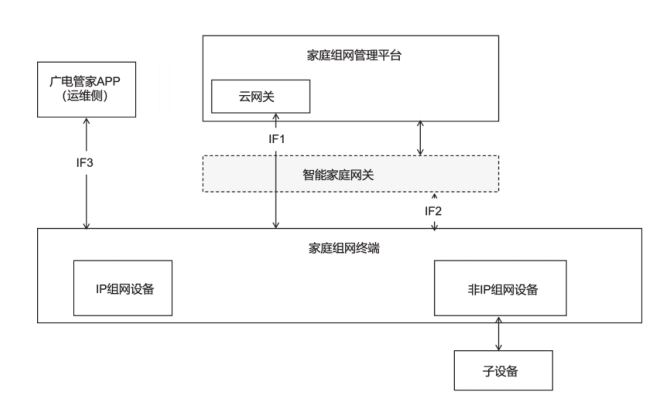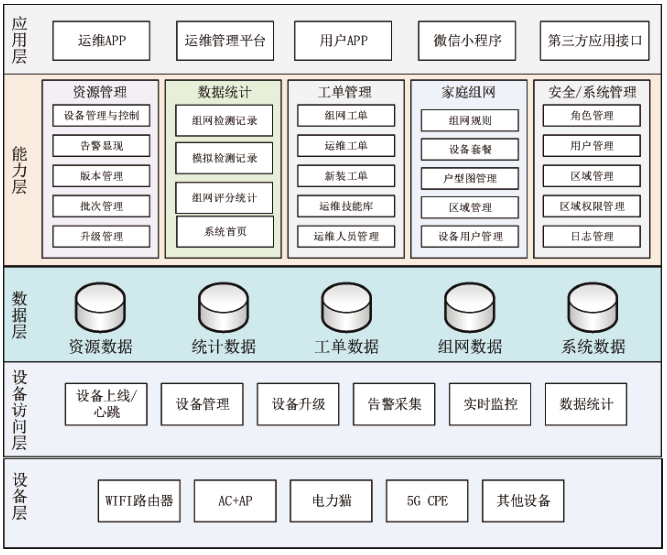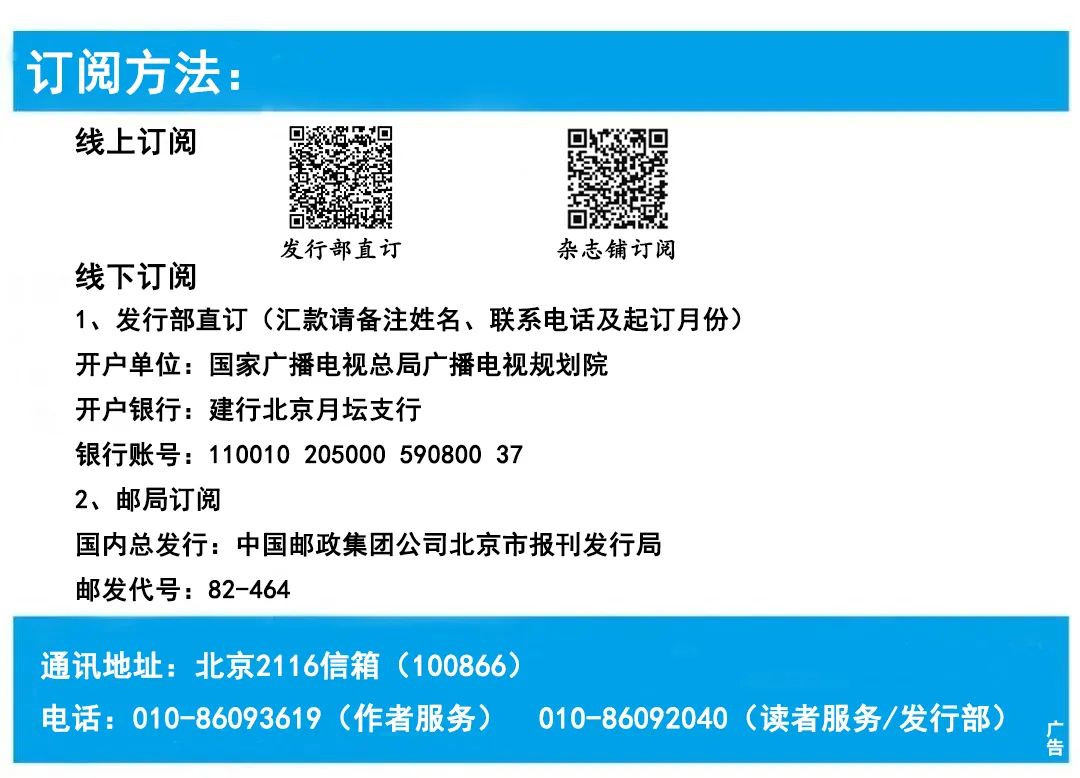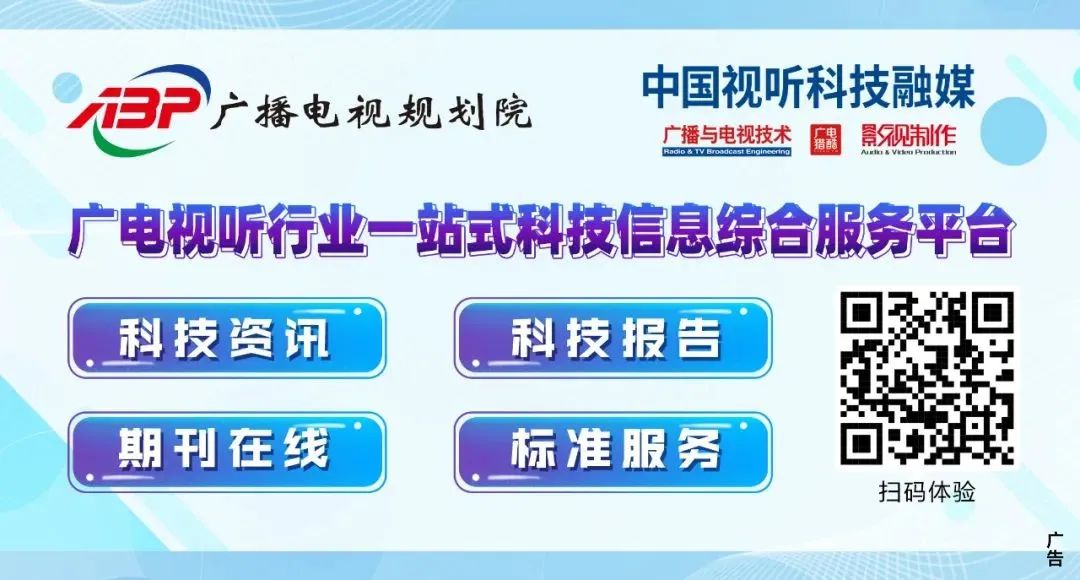
This article is an abstract of a paper originally published in “Broadcast and Television Technology”, issue 10 of 2023. You can read the full text online at lieku.cn.
Home networks are an important part of creating high-quality broadband services. By establishing a home networking management protocol, a family networking technical service system with broadcast and television characteristics can be built. This article describes the family networking management platform and related tools for family networking services, detailing the construction of the family networking service technical system from multiple aspects including requirements, design, and implementation. The family networking service technical system can provide end-to-end access quality assurance for broadband, television, and fixed-line voice users, achieving good economic and social benefits.
Authors:
Chen Qi, Hu Jun, Zhu Chenggang, Chen Houfu, Jiangsu Cable Technology Research Institute Co., Ltd.
Zhao Shijian, Jiangsu Provincial Broadcasting and Television Cable Information Network Co., Ltd.
Introduction of the First Author:
Chen Qi (1985—), male, senior engineer at Jiangsu Cable Technology Research Institute, master’s degree, mainly engaged in research on IPv6 and new metropolitan area networks, has participated in major projects such as TVOS and HINOC.
The family networking service must be meticulously designed. As the coverage network within a user’s home, it needs to meet various service requirements. These requirements include high-definition video demands such as 4K/8K, AR/VR, live video needs, security needs from home cameras, and smart device needs like smart locks and lights. Each of these demands has different requirements for bandwidth, latency, and jitter, which must be ensured through careful design for the best experience.
Family networking scenarios require thoughtful coverage. The home environment varies due to different layouts, spatial structures, and wall thicknesses. Different users have different hotspot coverage needs; beyond traditional living rooms and studies, some users require perfect coverage in specific areas like bathrooms, which are often more challenging due to architectural factors. Additionally, the wiring environment in homes can differ. New users may accept construction methods that affect appearance, such as trenching and wiring, while others may prefer methods that minimize aesthetic impact.
Family networking technology requires specialized selection. Currently, technologies available for family networking include WiFi routers, AC + distributed APs, FTTR, and 5G CPE. Each technology has different deployment convenience, bandwidth capacity, requirements for information points, wiring costs, and user acceptance, necessitating targeted matching of suitable products based on actual conditions.
Family networking services require professional platform support. Family networking services involve multiple steps including demand reception, work order dispatch, planning and design, effect verification, and inspection acceptance, all of which follow a specific sequence to form a closed service loop that collects comprehensive information about user services and iteratively improves user experience. At the same time, the implementation of family networking services needs to further reduce the technical requirements for operational maintenance teams, emphasizing service philosophy, standardizing service behavior, and enhancing service experience. These issues need to be addressed through a specialized platform.
Implementing family networking services requires a specialized technical team. The core of implementing family networking services lies in enhancing user connections. Through a specialized service team, the required services can be provided, deeply uncovering user needs and offering a thoughtful service experience. A specialized team must deeply understand the family networking technical system, distinguish complex and diverse family networking products, and provide users with the most suitable solutions; they should also master certain scenario-based deployment technologies and products to promote value-added services such as smart home while conducting family networking services.
Design of Family Networking Technical System
In the family networking industry ecosystem, broadcasting operators serve as service providers, leveraging third-party manufacturers’ routers, AC + AP, 5G CPE, and other family networking products to provide family networking services to users. The design of the family networking service technical system should focus on three aspects:
1. How to provide high-quality access services;
2. How to quickly respond to user service demands;
3. How to conveniently, efficiently, and professionally provide highly standardized family networking services to users.
To this end, we designed a service system, created a management protocol—C-link, and built a family networking management platform.
A service system: family networking services. Meeting users’ internal network coverage requirements to achieve an end-to-end true gigabit broadband experience. The service system encompasses a closed-loop service process from raising family coverage network needs, to family networking design, to selection of networking products, to verification of coverage effectiveness.
A management protocol: C-link protocol.
A family networking management platform: centered around the family networking service system and based on the C-Link management protocol, we established a convenient management, smart networking, and intelligent operation and maintenance management system that achieves self-management and early warning of network device management systems, creating a simplified service method where users see what they get. Additionally, through mini-programs and other multi-dimensional entry points, public users can manage home networking terminals remotely, enabling operations such as parental controls, device reboot, and wireless account password modifications. Furthermore, the family networking management platform integrates with the existing work order system, allowing grid personnel to check the status of networking terminals through the work order system, improving operational efficiency.
Introduction to the C-link Management Protocol
The C-Link protocol is based on the COAP protocol and is a protocol for unified access management, service management, and control management of wired broadband networking terminals. The C-Link management mechanism does not rely on physical home gateways, enabling unified management of IP networking terminals and non-IP networking terminals (see Figure 1).

Figure 1 C-Link Architecture Diagram
The C-Link defines a cloud gateway. Given that most broadband access devices in users’ homes are SFU layer-2 devices and that home gateway devices have not yet been deployed, a cloud gateway is required to achieve unified management of internal networking devices. The cloud gateway is a virtual network manager deployed in the cloud, not bound to ordinary users. When devices are networked, they automatically recognize the environment; if they cannot connect to a physical home gateway, they will connect to the cloud gateway.
Additionally, the C-Link protocol achieves information coordination and control synchronization between various network elements in family networking by defining interfaces IF1, IF2, and IF3. Among them, interface IF1 is the interface between family networking terminals and the cloud gateway. Interface IF2 is the interface between family networking terminals and smart home gateways. Interface IF3 is the interface between family networking terminals and the broadcasting networking product APP.
The family networking management platform is divided into five levels from bottom to top: the device layer consists of various networking devices that access the family networking management platform; the device access layer is the management capability layer of the family networking management platform for networking terminals, including six major functions such as device online detection, device network management, and device upgrade management; the data layer is a unified data pool of the family networking management platform, covering core information such as resource data, work order data, and networking data; the capability layer is a set of services provided by the networking management system to upper-layer applications, including five major functions such as resource management and data statistics; the application layer provides various tools for operation and maintenance personnel, business operation personnel, and end users.
The family networking management platform provides unified access management for mainstream family networking terminals such as WiFi routers, AC + AP, powerline adapters, and 5G CPE. The networking management platform achieves online status data collection, status monitoring and querying, and remote configuration and management of family networking terminals through protocol passthrough (see Figure 2).


Figure 2 Platform System Architecture
The main functions of the software platform include: device management, work order management, intelligent operation and maintenance, one-click repair, operation and maintenance toolbox, and visual monitoring.
1. Device management function
By adding/editing device categories, adding device identification codes, and associating device areas, unified management of family networking terminals is achieved.
2. Work order management function
The completion progress of installation work orders and operation and maintenance work orders can be realized through the invocation of the work order system, allowing for real-time progress tracking.
3. Intelligent operation and maintenance function
When operation and maintenance personnel repair devices, they can support remote viewing of device status in the work order system without needing to go to the device location if the device is online. They can perform one-click operation and maintenance, optimization, device upgrades, factory resets, reboots, and modifications of WiFi usernames and passwords, as well as internet settings. At the same time, even when the device is offline, they can view the device status by connecting to the device’s WiFi without entering the user’s home and manage the device.
4. One-click repair function
Supports users in one-click reporting of device repairs in the mini-program without needing to fill in any information, with the system pushing repair information to maintenance personnel, reminding them to go for repairs, while also supporting customer service for manual repairs.
5. Operation and maintenance toolbox function
Specially provides operation and maintenance personnel with a WiFi environment analysis toolbox, including spectrum analysis, channel recommendations, co-channel and adjacent-channel interference situations, ping testing, network speed testing, AP environment tools, etc., facilitating WiFi environment analysis during maintenance.
NO.5
Currently, the family networking management platform has been established, capable of supporting 500,000 terminals through high-performance servers. The platform has been trialed in multiple cities and districts within Jiangsu Province. It has connected over 20,000 terminals and served over 20,000 users, with more than 300 maintenance personnel effectively supporting the development of family networking services across the province. The platform, based on the Jiangsu Cable C-link protocol, achieves unified management of devices supporting the C-Link protocol. It has constructed a family networking service system and a full-process family networking service. By establishing standardized service processes with electronic records at key nodes, it has greatly improved customer satisfaction. Additionally, the platform provides means for remote operation and maintenance. Through the platform, maintenance personnel can promptly troubleshoot issues via remote control and viewing, reducing the difficulty and workload of operation and maintenance. Furthermore, the platform has already integrated with multiple networking terminal manufacturers, achieving compatibility with over ten models of networking terminals, initially establishing an ecosystem for broadcasting family networking products.
By constructing our own management protocol, we have built a family networking service technical system with broadcasting characteristics. The establishment of this technical system can fully leverage the service advantages of broadcasting, assisting broadcasting operators in leveraging routers, AC + AP, and other specific devices to tap into the broadcasting broadband family networking market. The construction of the management platform within the family networking technical system simplifies the operational maintenance workload while providing operators with precise means to understand network status through the collection of network information, laying the foundation for data operations.



[1]Chen Qi, Mao Haibo et al. Implementation of IPv6 Address Allocation System for Set-top Boxes Based on Stateful DHCPv6 [J]. Broadcast Television Network, 2023 (1).
[2] Chen Houfu, Chen Qi, Zhu Zhongjin. Development Ideas for Jiangsu Cable Family Networking Business [J]. Broadcast Television Network, 2021 (12).
Advertising and business cooperation for “Broadcast and Television Technology” and “Guangdian Lieku”:
Beijing Zhongguang Xintong Cultural Media Co., Ltd.
Contact: Li Cong
Phone: 18518221868
Please share this good article and leave a message if you have something to say.
